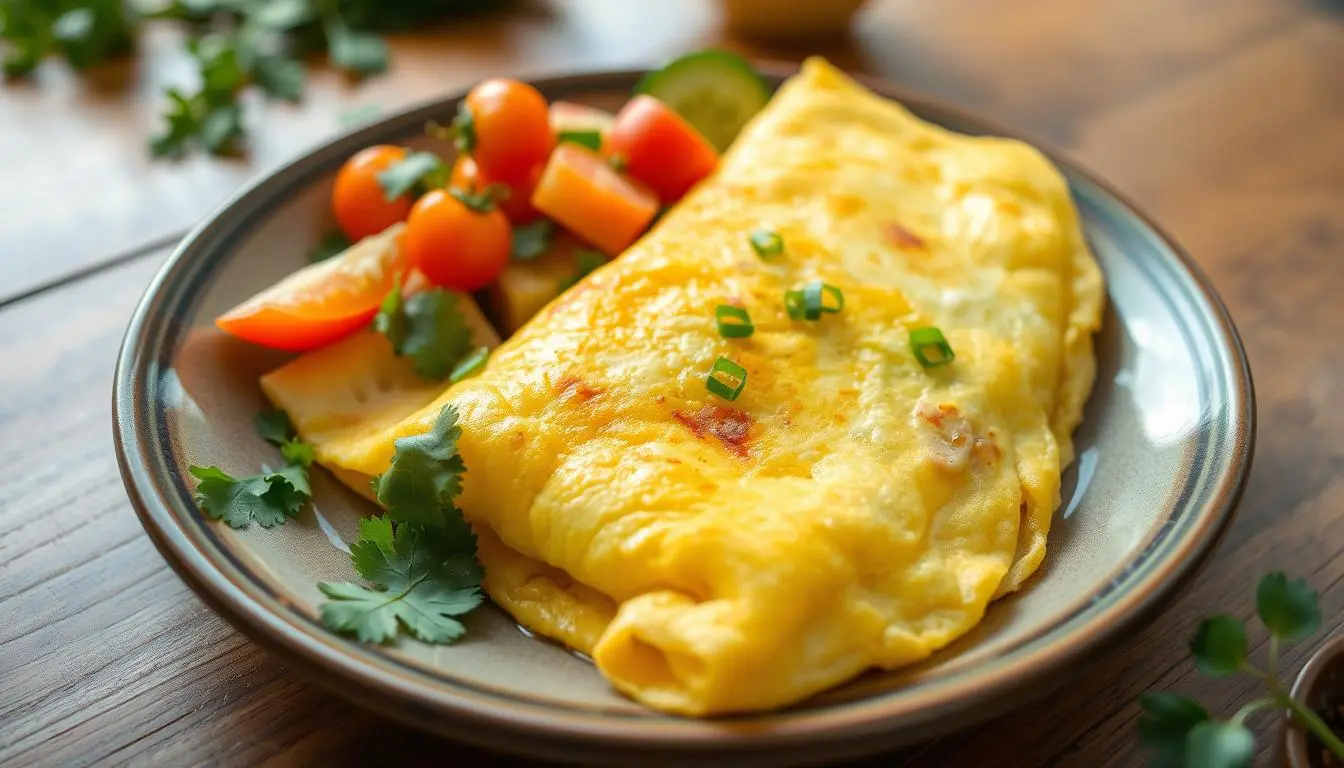Imagine a golden, crispy Vietnamese omelette sizzling on a hot skillet. Its edges are perfectly caramelized, releasing a scent that wakes up your senses. This dish turns an ordinary morning into a special culinary adventure.
Growing up in a family that loved food, I found the magic of Vietnamese cuisine. That first bite of a Vietnamese omelette changed everything. It wasn’t just breakfast; it was a journey through culture, wrapped in delicate, crispy layers.
So, what makes this egg dish so special? It’s the mix of textures, vibrant flavors, and rich cultural heritage. From street vendors in Hanoi to home kitchens across Vietnam, it’s more than a meal. It’s a celebration of culinary artistry.
The Rich History Behind Vietnamese Omelette
The Vietnamese omelette is a delicious testament to the country’s complex culinary heritage. It shows the blending of cultures and innovation that started in the French colonial era.
Origins in French Colonial Vietnam
In the French colonial period, European cooking met Vietnamese ingredients. Chefs in Hanoi and Saigon mixed French omelette recipes with local flavors. This created a lighter, crispier omelette that was uniquely Vietnamese.
- French cooking techniques introduced egg whisking methods
- Local ingredients added distinctive Vietnamese flavors
- Culinary innovation became a form of cultural expression
Evolution into Street Food Vietnam
Over time, the omelette moved from fancy dining rooms to lively street markets. Street food vendors made it affordable and tasty for workers and families. It became a key part of street food in Vietnam, showing great taste and value.
“Every bite tells a story of cultural resilience and culinary creativity” – Vietnamese Food Historian
Cultural Significance in Vietnamese Breakfast
Today, the Vietnamese omelette is more than a meal. It’s a morning tradition that brings families together. It shows the adaptability and creativity of Vietnamese cuisine, enjoyed in markets and kitchens alike.
Essential Ingredients That Make Vietnamese Omelette Special
Making a Real Vietnamese Omelette needs a special mix of ingredients. These turn simple eggs into a dish that’s truly amazing. Vietnamese food loves fresh, bright tastes that make these pancakes unique.
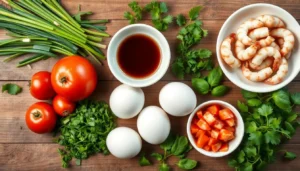
The secret to a great Vietnamese omelette is in its ingredients:
- Fresh farm eggs – best if they’re free-range for a deeper taste
- Fragrant Vietnamese herbs like cilantro and scallions
- Fish sauce – a key ingredient that adds a lot of umami
- Protein like ground pork or shrimp
Your omelette’s flavor comes from ingredients that make it special. Nuoc cham, a tangy sauce, adds even more depth. Street vendors in Vietnam often add bean sprouts or mushrooms to make their own versions.
“The magic of Vietnamese cuisine is in its ability to transform simple ingredients into extraordinary flavors” – Chef Mai Nguyen
Every ingredient is important for a dish that’s both tasty and true to Vietnamese cooking.
The Perfect Vietnamese Omelette Technique
Making an authentic trung op la needs precision and passion. Asian omelets are more than a quick breakfast. They are a culinary art form that requires skill and attention to detail.
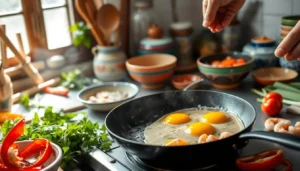
Mastering the Vietnamese omelette is not just about ingredients. It’s about finding the right balance of technique and flavor.
Preparing Your Ingredients
Your preparation is key to a great trung op la. Start by gathering high-quality ingredients:
- Fresh eggs at room temperature
- Finely chopped green onions
- Protein of choice (typically minced pork or shrimp)
- Seasoning like fish sauce and pepper
Mastering the Flip
The signature move of Asian omelets is the perfect flip. Use a non-stick pan with a thin layer of oil. Make sure it’s hot but not smoking. Pour your egg mixture and let it cook until the edges become crispy.
“The secret is in the wrist—a gentle, confident motion creates the perfect fold,” says Chef Nguyen from Hanoi Street Foods.
Achieving the Ideal Texture
Your goal is a golden-brown exterior with a soft, pillowy interior. Keep the heat at medium and watch your omelette closely. The trung op la should be crisp outside, tender inside—a delicate balance that takes practice to perfect.
- Keep heat consistent
- Don’t overcrowd the pan
- Use quick, decisive movements
With patience and practice, you’ll create Vietnamese omelettes that rival those found in the bustling street markets of Saigon.
Regional Variations of Vietnamese Omelette
Vietnam’s food scene is full of different tastes, and the Vietnamese omelette is a big part of it. Each area has its own special way of making this dish. This turns a simple egg dish into a colorful culinary adventure.
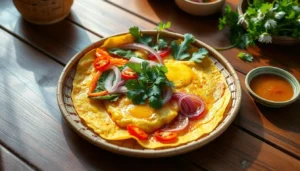
In Saigon, egg dishes are a big deal. Southern Vietnam is famous for banh khot, tiny crispy pancakes. They are made in special pans, giving them a perfect crunch.
- Central Vietnam has a heartier omelette with lots of local seafood
- Northern regions have a lighter, herb-filled version
- Coastal areas often use fresh seafood in their egg dishes
These variations are all about local ingredients and cooking ways. In Saigon, banh khot might have shrimp or ground pork on top. Mountain areas might add wild mushrooms or special spices.
“Every region tells a story through its omelette” – Vietnamese Culinary Tradition
Each version shows Vietnam’s cultural variety and deep food history. From Saigon’s crispy omelettes to the soft, herb-filled ones elsewhere, these dishes are more than food. They are a tasty trip across Vietnam.
What Sets Vietnamese Omelette Apart from Other Egg Dishes
Vietnamese Omelettes are a unique treat in the world of egg dishes. They differ from American or French omelettes. These dishes add a special twist to breakfast and street food.

Unique Cooking Methods
Making a Vietnamese omelette is quite different. Chefs use high heat and quick cooking. This makes the outside crispy and the inside airy.
- Ultra-high heat cooking
- Rapid folding technique
- Thin, crispy edges
Distinctive Flavor Profile
Vietnamese omelettes have a unique flavor. They mix eggs with herbs, fish sauce, and sometimes meat. This creates a taste that’s hard to find in other egg dishes.
A Vietnamese omelette isn’t just a meal—it’s a flavor journey that awakens every taste bud.
Traditional Accompaniments
Enjoying a Vietnamese omelette means trying its traditional sides. You’ll find fresh herbs, pickled vegetables, and special sauces. These add to the dish’s appeal.
- Fresh cilantro
- Pickled daikon
- Nuoc cham sauce
Every bite of a Vietnamese omelette is a story. It’s about tradition, texture, flavor, and culture all in one dish.
Health Benefits of Starting Your Day with Vietnamese Omelette
Vietnamese cuisine brings a tasty twist to egg dishes, making breakfast exciting. A Vietnamese omelette is not only tasty but also full of nutrients to start your day right.
Traditional Vietnamese omelettes are packed with protein, offering many health benefits. Making this dish is more than cooking a meal. It’s about creating a balanced meal that boosts your health.
- High-quality protein from fresh eggs
- Essential amino acids for muscle repair
- Low-calorie breakfast option
- Nutrient-dense ingredients supporting metabolism
Vietnamese egg dishes often include veggies and herbs. These add important vitamins and minerals to your breakfast. They help keep your immune system strong and give you energy all morning.
“Eating a Vietnamese omelette is like giving your body a nutritional love letter,” says Chef Mai Nguyen.
Compared to American breakfasts, Vietnamese omelettes are lighter and more nutritious. They mix lean proteins with fresh veggies. This makes them a great choice for those who want a healthy and filling meal.
Best Side Dishes and Accompaniments
Take your Vietnamese omelette to the next level with street food vietnam side dishes. These dishes turn a simple egg dish into a masterpiece. The right sides can make your meal unforgettable.
👉 Traditional Pairings
Vietnamese omelettes are best with classic sides that match their rich taste. Here are some traditional options:
- Fresh herbs like mint and cilantro
- Pickled vegetable medley
- Steamed rice
- Crisp cucumber slices
👉 Modern Fusion Options
Modern chefs are mixing up street food vietnam classics with new pairings. Try these fresh ideas:
- Kimchi slaw
- Sriracha-infused coleslaw
- Avocado salsa
- Spicy mango chutney
👉 Sauce Combinations
The perfect sauce can make your Vietnamese omelette unforgettable. Here are some tasty sauce options:
- Nuoc cham: Traditional Vietnamese dipping sauce
- Chili garlic sauce
- Ginger-soy reduction
- Tangy tamarind glaze
Pro tip: Mix and match these accompaniments to create your personal flavor adventure!
Tips for Making Restaurant-Quality Vietnamese Omelette at Home
Learning to make trung op la takes practice and some secrets from the pros. Start by mastering the techniques used by chefs in Vietnamese kitchens. This will help you make authentic Asian omelets.
Having the right tools is important. Get a top-notch non-stick skillet and a thin spatula. These tools help you flip the omelette perfectly and get that golden-brown look.
“Cooking is about passion, and with these tips, you’ll bring the streets of Vietnam right into your kitchen.” – Chef Marie Nguyen
- Use fresh, room-temperature eggs for smoother mixing
- Whisk eggs thoroughly to incorporate air
- Maintain medium-high heat for crispy edges
- Practice your flipping technique with confidence
Temperature control is crucial for making trung op la. Your pan should be hot enough to make the edges crispy but not too hot to burn the eggs. A seasoned cast-iron skillet helps with even heat and prevents sticking.
Try different fillings like green onions, bean sprouts, or minced pork. This lets you add your own twist to the dish. The beauty of trung op la is in its flexibility and your creativity.
Common Mistakes to Avoid When Making Vietnamese Omelette
Making a perfect vietnamese omelette takes skill and practice. Many home cooks face challenges that can ruin this tasty dish. Knowing these common mistakes will help you make a dish that rivals restaurants.
Mastering the art of vietnamese omelette requires attention to detail. Let’s look at the most common mistakes that can mess up your cooking.
👉 Controlling Kitchen Temperature
Temperature is key when making savory pancakes. Cooking at too high or too low heat can ruin the omelette’s texture. Here are some temperature tips:
- Use medium-high heat for consistent cooking
- Preheat your pan to ensure even heat distribution
- Watch for slight smoke as a sign of perfect pan readiness
👉 Getting Ingredient Proportions Right
Getting the right mix of ingredients is an art in making vietnamese omelette. The wrong mix can cause:
- Soggy or overly dry textures
- Bland flavor profiles
- Structural integrity problems
👉 Timing and Technique Precision
“The difference between a good and great vietnamese omelette is often just seconds.” – Professional Chef
Perfecting your timing means:
- Whisking eggs until just combined
- Flipping at the exact right moment
- Avoiding excessive manipulation of the omelette
Practice is key to mastering the art of vietnamese omelette. With patience and focus, you’ll soon become a pro at making these savory pancakes.
Where to Find the Best Vietnamese Omelette in Major US Cities
Exploring Vietnamese cuisine means finding hidden gems across America. If you’re looking for an authentic taste of Saigon, these cities have amazing Vietnamese omelette spots. They will make your taste buds dance with joy.
- San Francisco, California: Home to a vibrant Vietnamese food scene with numerous authentic restaurants
- Houston, Texas: Boasting a large Vietnamese community with exceptional street food options
- Seattle, Washington: Known for innovative Vietnamese culinary experiences
- New York City, New York: Diverse food landscape with multiple Vietnamese eateries
When searching for the perfect Vietnamese omelette, look for restaurants that use fresh ingredients and traditional cooking. Find places with chefs who know the true flavors of Vietnamese cuisine.
“The best Vietnamese omelettes are a perfect balance of crispy exterior and soft, flavorful interior.” – Chef Mai Nguyen
Pro tips for finding exceptional Vietnamese omelettes:
- Check local food blogs and reviews
- Visit Vietnamese neighborhoods
- Ask for recommendations from local Vietnamese communities
- Look for restaurants specializing in Saigon specialties
Remember, the most authentic experiences often come from small, family-owned restaurants. They have perfected their craft over generations.
Your journey into Vietnamese omelette shows it’s more than breakfast. It’s a mix of history, flavor, and tradition. Every bite shares stories of French influence and Vietnamese creativity.
This dish shows how food can bridge cultures. It’s perfect for home cooks or food lovers wanting real tastes. It’s easy to make and full of Vietnamese flavors.
Learning about Vietnamese omelette is more than getting a recipe. It’s about experiencing a meal that changes simple eggs into something special. Try it and bring a bit of Vietnam to your meals.
Now you can enjoy, make, and share the Vietnamese omelette’s magic. Begin your cooking journey today. Let your taste buds discover its rich, complex flavors.
FAQ
What makes Vietnamese omelettes different from traditional Western omelettes?
Vietnamese omelettes, or trung op la, are crispier and thinner than Western ones. They’re cooked at high heat for a golden, crispy outside and a soft inside. They often include fresh herbs and are served with pickled vegetables and dipping sauces.
Are Vietnamese omelettes healthy?
Yes! They’re full of protein from eggs and have nutritious herbs like cilantro and green onions. They’re lighter than traditional breakfasts, offering a balanced meal. When made with little oil, they’re a nutritious breakfast choice.
Can I make a Vietnamese omelette if I’m not an experienced cook?
Absolutely! Making a Vietnamese omelette is simple. You need eggs, herbs, and a hot pan. Watch videos and practice to get the crispy texture right. The key is the right pan temperature and experimenting.
What are traditional accompaniments for Vietnamese omelettes?
They’re served with fresh herbs, pickled vegetables, and nuoc cham (a tangy dipping sauce). Regional variations might include rice paper, fresh greens, or more conditions.
Is a Vietnamese omelette the same as banh khot?
While similar, they’re not the same. Banh khot are mini savory pancakes, often smaller and thicker. Both are delicious Vietnamese street foods, but different in preparation and texture.
Can vegetarians enjoy Vietnamese omelettes?
Yes, vegetarians who eat eggs can enjoy them. Add vegetarian ingredients like tofu, mushrooms, or extra veggies. Just skip the meat-based accompaniments.
What’s the best pan to use for making Vietnamese omelettes?
Use a non-stick skillet or a well-seasoned cast-iron pan. They should handle high heat well and help the omelet get crispy without sticking. Make sure your pan is hot before adding the egg mixture.
Print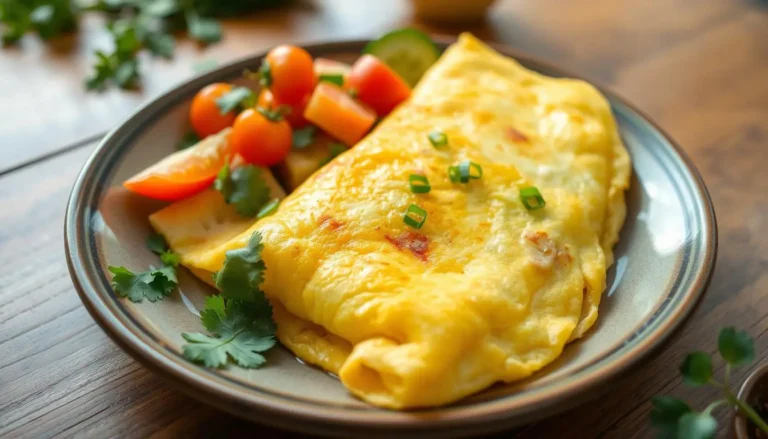
Vietnamese Omelette With Fresh Herbs
This delightful Vietnamese Omelette combines the savory flavors of fish sauce, soy sauce, and fresh vegetables.
It’s a quick and easy breakfast option that’s packed with nutrients and perfect for a healthy start to your day. Enjoy it hot with a side of crusty bread or rice for a satisfying meal.
- Total Time: 20 minutes
- Yield: 2 servings 1x
Ingredients
- 4 large eggs
- 1 tablespoon fish sauce
- 1 teaspoon soy sauce
- 1/4 cup finely chopped onion
- 1/4 cup finely chopped tomato
- 1/4 cup finely chopped bell pepper
- 1/4 cup finely chopped mushrooms
- 1/4 cup finely chopped green onions
- 2 tablespoons vegetable oil
- Salt and pepper to taste
Instructions
- In a large bowl, whisk together the eggs, fish sauce, and soy sauce until well combined.
- Heat 1 tablespoon of vegetable oil in a large non-stick skillet over medium-high heat.
- Add the chopped onion, tomato, bell pepper, and mushrooms. Sauté for 3-4 minutes, or until the vegetables are tender.
- Pour the egg mixture over the sautéed vegetables, spreading it evenly.
- Cook for 2-3 minutes, or until the edges start to set.
- Sprinkle the chopped green onions over the omelette.
- Fold the omelette in half and cook for an additional 1-2 minutes, or until the eggs are fully cooked.
- Slide the omelette onto a plate, cut into wedges, and serve hot with a side of crusty bread or rice.
- Prep Time: 10 minutes
- Cook Time: 10 minutes
- Category: Breakfast
- Method: Fried
- Cuisine: Vietnamese
- Diet: Gluten Free
Keywords: Vietnamese Omelette

